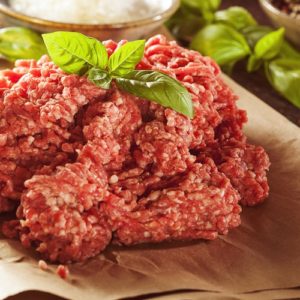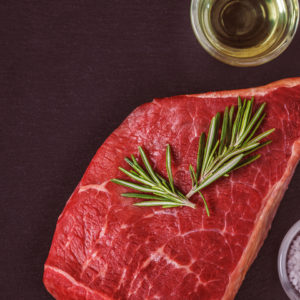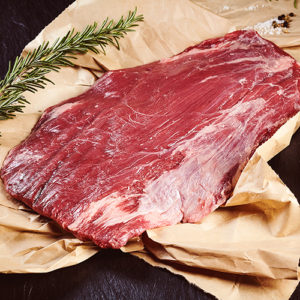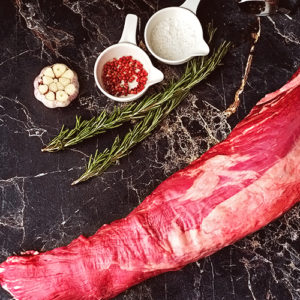Learn Your Cuts

 Chuck
Chuck
What is it: The largest, most heavily-worked group of muscles on the animal, which means it needs to be cooked for several hours. Chuck is your stereotypical pot roast; it’s also great ground into a burger blend.
Where it is on the cow: Shoulder muscle
Fat content/marbling: Chuck contains connective tissue (fat and collagen) that breaks down when you cook it.
How to cook it: A go-to economical cut for slow cooking, chuck can be prepared by your butcher as a roast, or as stew meat that’s perfect for beef Bourguignon. You can do a barbecue-style chuck as well, where you smoke it and then braise it.
Brisket
What is it: One of the most heavily-worked parts of the animal. It’s tough, but when cooked low and slow, it has a nice texture that allows it to shred apart.
Where it is on the cow: The lower chest, right underneath the front leg
Fat content/marbling: Brisket is fatty and well-marbled
How to cook it: Famous cut for BBQ; rub it and slow-smoke it until it’s falling apart. It’s also good for braising as a pot roast, and making corned beef.
 Top Sirloin
Top Sirloin
What is it: When you take a cross-section of the whole sirloin, it’s typically called a “top sirloin” steak. Jermasek isn’t the biggest fan of the traditional top sirloin; he says there are too many different cuts in the one steak, causing it to cook unevenly. He likes to break down the sirloin into its different parts, including what’s known as the “top sirloin cap” (also called the picanha in Brazil and culotte in France). Ask your butcher for a “top sirloin cap” the next time you want to cook a delicious steak at home.
Where it is on the cow: The lower back/upper butt area
Fat content/marbling: Lean, but very tender. Top sirloin has a really nice fat cap on the top, which makes up for the lack of fat within the muscle.
How to cook it:
- To cook the top sirloin cap: Sear for 4 to 5 minutes on each side, until it gets good color. Be sure to render some of the fat on top (the fat cap) by placing it face-down in the pan. What you’re looking for is a nice brown caramelized fat. Cut the steak horizontally so you end up with a small piece of the fat on every part. Alternatively, skewer and grill the top sirloin cap like they do in Brazil.
- To cook a traditional top-sirloin steak: Cook a couple of minutes on each side, then finish it off in the oven.
Short rib
What is it: Short ribs are fatty and relatively tough, so you need to cook them for a long time to make sure they’re tender. When braising, you should ask for bone-in short ribs; tons of flavor will be leached out of the bone as it braises. Short rib is also excellent in burger blends.
Where it is on the cow: Short rib comes from a larger primal cut called the “short plate”; it’s the large pieces of rib that extend down from the ribeye.
Fat content/marbling: One of the fattier parts of the animal (some areas of the short rib can be 50/50 fat-to-lean meat)
How to cook it: Braise bone-in short ribs anywhere between two and four hours. Alternatively, if you want to make Korean galbi, you can ask your butcher for short rib “flanken”cut across the bone.
 Flank
Flank
What is it: Flank steak looks like a big paddle or balloon-shaped piece of meat; it has a really long grain to it and is good for quick-searing.
Where it is on the cow: Underbelly
Fat content/marbling: Lean with mild flavor
How to cook it: Flank is a good cut to marinate and sear super fast. When you slice it against the grain, it has a really nice texture because you’ve cut all the connective tissue. Flank is the typical cut used for carne asada.
Round
What is it: The round is a massive piece of meat. It’s made up of the top round, bottom round, eye round, and a muscle called the sirloin tip. All of these different muscles have different uses. Many of them make good roast beef—specifically, the sirloin tip and bottom round. London broil is typically made with top round.
Where it is on the cow: The hind leg
Fat content/marbling: Minimal fat and marbling
How to cook it: Make roast beef with the sirloin tip and bottom round; make London broil with the top round. (Recently, at the opening of Belcampo Meat Co.’s Santa Monica location, Jermasek cooked a whole round and set it ablaze.)
 Tenderloin (chateaubriand, filet mignon)
Tenderloin (chateaubriand, filet mignon)
What is it: The tenderloin is one of the least-worked muscles on the animal, which is why it’s so tender. Chateaubriand is the thicker butt-end of the tenderloin, and the center-cut portion is what everyone knows as filet mignon. People gravitate towards the filet because it’s like the “boneless, skinless chicken breast of the cow,” says Jermasek.
Where it is on the cow: The muscle that sits right up above the spinal cord, at the lower back area.
Fat content/marbling: Low in fat, very tender
How to cook it: If you’re cooking chateaubriand, slow roast it rather than searing it hard and roasting it fast. Jermasek likes to crust the chateaubriand with black pepper, thyme, and shallots, and wrap the whole piece in “caul fat” (beautiful web-like pork fat). He then slow roasts the chateaubriand, and cranks the heat up at the end to give the meat nice color. What you’ll have is a “buttery, melt-in-your-mouth filet thanks to the pork fat.” For a filet or filet mignon, don’t mess with it to much: sear it on both sides, put some salt on it, and let it rest a few minutes
